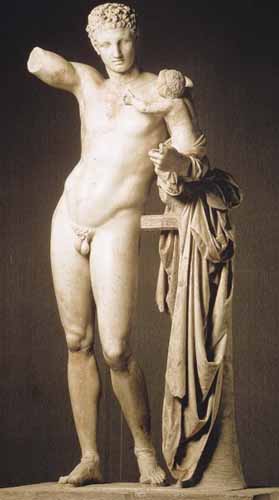
Hermes statue created by the famous scupltor Praxiteles
The ancient Greeks believed that he was a young joyful man who used to engage himself in tricky jokes and cheatings. As the messenger of the gods, he could move very fast and he was said to fly like the wind. In the ancient Greeks’ mind, Hermes embodied rapidity, flexibility, fluidity and even the human tendency of making mistakes. Among his human characteristics, Hermes was also said to be a liar, a deceiver and even a thief!
Zeus and Maia had lain together in a cave located in the area of Kyllene, Arcadia. Actually, Maia who was one of the Pleades of ancestry, born by Atlas and Pleoni, used to live there isolated. However, Zeus found Maia and then mated with her. Hermes was born after their coupling and from the very first moment of his birth he was a clever and crafty baby. According to the greek mythology, Hermes escaped from his cradle and exited the cave where his mother had placed him.
On his way out, he stubbed on a turtle and, inspired by its shape, he emptied it shell and stretched a piece of cow leather over its open side. Then he placed two reeds on the sheel and stretched stripes made of cow guts along them. In this way, he created a musical instrument known as lyre.
The young god played his lyre for a long time but once having been hungry he looked for food. His hanger led him to the north in Pieria where his brother, Apollo, herd his cows. Hermes stole a the best cows of the herd and led them to Arcadia but he had them walking in the reverse direction in order to make their traces confusing This trick shows us that Hermes was agile and tod even during his infancy. After having arrived back to Arcadia, he ate and he did not omit to sacrifice a cow to the Olympian gods. Continuously, he went back to his cradle “passing through the keyhole, like the wind” and slept so that his mother be unaware of his actions.
When Apollo took notice of the theft and once having realized that it had been made by Hermes, he went to Arcadia and complaint to Hermes; mother. The young god, pretending being innocent, he proposed Apollo to present both of them, to Zeus who would solve their difference. Zeus, surprised by his young son’s brightness found his actions cute and funny so he asked him just to return the cows back to Apollo, without punishing Hermes. However, Hermes tried to allay Apollo’s anger by gifting him his lyre. The two gods made friends since then and they loved each other for ever.
Being pleasant and crafty, he managed shortly to be graced by all the Olympian gods. Zeus, impressed by his exceptional abilities, trusted him as his messenger and Hades charges him with the transferring of the dead people to the Underworld. Hermes became then the one that could move on the earth, in the air and even in the Underworld freely! He usually transferred confidential messages of Zeus such as the order to Hades for letting Persephone return to her mother.
The king of the gods had also sent Hermes to steal Eo who had been turned to a cow by Hera. Hermes managed to deceive the person who guarded Eo, by making him sleep thanks to the sound of his lyre. He also freed the god Ares who had been imprisoned in a cauldron by the twin giants named Aloades, thanks to his ingenuity. Moreover, Hermes had transferred Frixos and Elli on his golden ram and it was him who assisted Odysseus when the hero was imprisoned in Kirki’s island. Hermes had also stolen the dead Alcmene who was Hercules's mother and carried her to the Blests' Island where she got married to Rhadamanthus.
Sculptors used to depict Hermes with wings on his shoulders as he was believed to fly and often characterized as the air god. He was holding a golden wand adorned with two snakes, the "cadideus" given to him by his brother Apollo.
Hermes is mainly depicted as a young breadless boy with wing sandals. Praxiteles, one of the most talented sculptors of ancient Greece, has depicted Hermes as a young god holding the newly born Dionysus, as he was transferring the baby to the Nymphs who would raise Dionysus. This is considered to be one of the greatest sculptors of the ancient world and it is housed in the Archaeological Museum of Olympia.
